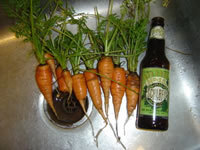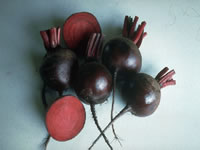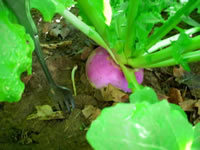|
Watering and Fertilizing Root Vegetables
Root crops require regular, deep soaking to promote good root development.
With most soil types, a weekly watering is sufficient, but very sandy soils may require more frequent watering.
Root crops need about 2 gallons of water per square yard each week, by rain or by irrigation.
Apply a heavy layer of mulch to help control weeds
and keep the soil moist and cool.
Carrots and Radishes will benefit from a light side-dressing of a organic vegetable fertilizer spread 2" out from each side of the row.
Regular applications of compost tea will help to insure a good, productive harvest from all of your vegetable crops.
Compost Tea can be made by putting a shovel or two of finished compost
or well-rotted manure into a nylon or cheese cloth bag and steeping it in a
5 gallon bucket of water for 5-7 days.
Compost or manure tea can be used every 3-4 days for foliar feeding
or as part of your watering schedule. |
|
|
 |
How to Plant and Grow Carrots, Daucus carota 'Sativus'
Carrots are hardy, biennial plants that are best when grown as annuals.
They have 20" tall, fern-like foliage and edible, orange or yellow roots.
Plant Carrot seeds ½" deep, directly in the garden as soon as the soil can be worked in the spring.
Sow seeds at the rate of about 25 seeds per foot of row, in rows spaced 12"-18" apart.
Germination takes from 14-21 days.
When the seedlings are 2" tall, thin plants to 2" apart.
Plant successive crops every three weeks until early summer.
Carrots are ready to harvest in about 90 days after planting. |
 |
How to Plant and Grow Beets, Beta vulgaris
Beets are cool weather, biennial plants that are best when grown and harvested as annuals.
Both their roots and leafy tops are edible and are very high in iron.
The Beet "seeds" that you buy are actually fruit capsules containing several seeds. Soak them in warm water for 24 hours before planting them in the garden, ½" deep in rows 18"-24" apart in early spring. Germination takes 10-14 days.
Plant successive crops every 3 weeks until June.
Because the seedlings will emerge in clumps, the first thinning should be done almost immediately. Thin again when there are 3 or 4 leaves. When the plants are 5"-6" tall, gradually remove additional plantlets until they are spaced 4" apart. Thinned plants and beet tops can be eaten. Harvest Beets in 40-70 days or when they are 2"-3" for the best flavor. Dig and store late Beets in a cool place prior to the first freeze. |
 |
How to Plant and Grow Radishes, Raphanus sativus
Radishes are cool season crops that are fast growing and easy to care for.
The roots may be white or red, round or elongated (up to 9" long).
Plant Radish seeds ½" deep, directly in the garden as soon as the soil can be worked in the spring. Sow seeds 1"-2" apart, in rows spaced 6"-12" apart. Germination takes from 4-6 days.
Plant successive crops every 15 days until late spring. A fall crop can be planted in late summer.
Small types of Radishes are ready to harvest in 3-4 weeks.
Most larger types take 8-10 weeks after planting.
|
 |
How to Plant and Grow Turnips, Brassica rapa 'Rapifera'
Plant Turnip seeds ½" deep, directly in the garden as soon as the soil can be worked in the spring. Sow seeds 3"-5" apart, in rows spaced 15"-18" apart. Germination takes from 7-10 days. Plant successive crops every 3 weeks up until 5 weeks before expected 80° weather. A fall crop can be planted in late summer.
Early Turnips will be ready for harvest in about 5 weeks. Later crops may take 8-10 weeks. Harvest Turnips when they are about 2" across. If left in the ground too long, they will become woody. |
Insect Pests and other Problems that Affect Root Crops
Aside from the slugs and snails that will quickly devour seedlings and young plants, there are several other
pests and problems that can affect, damage or destroy your Root Crops.
Carrot Rust Flies
Carrot Rust Flies lay their eggs in young leafy growth or in the soil next to plants.
Their larvae feed the roots of many root crops, where they burrow into the roots and render them inedible and mushy.
Use floating row covers to shelter your crops from flying insects until they are well established.
Flea Beetles
Flea Beetles chew small, round holes into the leaves of many different crops.
Flea Beetles can spread diseases to other crops in the garden, but their biggest threat is to young seedlings
that can quickly die from the damage caused by these bugs.
Keeping the garden free of weeds and debris throughout the entire year will lessen the chance of a Flea Beetle infestation.
Floating row covers will help somewhat, but keeping the ground moist and the foliage misted will make the plants
far less likely to become breeding grounds and lessen the likelihood of plants being attacked.
Cabbageworms and Cabbage Loopers
Cabbage Butterflies and Gray Moths lay their eggs on the leaf surface and within a few days the caterpillars
hatch and begin to feed. Hand pick the caterpillars, cocoons and eggs as they are found.
Trichogramma Wasps, Yellow Jackets and Lacewings are all natural predators of these worms.
Using floating row covers to shelter your crop in early spring will lessen the chance
of a major problem for the rest of the season.
Root Maggots and other Harmful Insects
Root Maggots are ¼" long, white worms that live in the soil and feed
on the roots of plants, causing them to become yellow and stunted.
Beneficial Nematodes added to the soil will quickly hunt down and kill Root Maggots and many other soil dwelling insects.
Harlequin Bugs are ½" long,shiny black Stink Bugs with bright reddish orange markings.
Harlequin Bugs suck on the foliage, leaving yellow blotches and eventually killing the plant.
Hand pick and destroy individual bugs or use an insecticidal soap spray.
|




